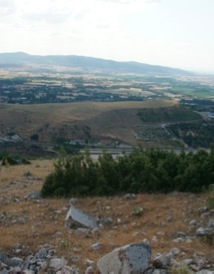



The city of Kelainai is often mentioned in written sources as being an important meeting point of important lines of communication. Thus, the armies of Xerxes, Cyrus the Younger (Xen. An. 1.2.7-8), Alexander the Great (Arr. An. 1,29,1 ; Curt. 3,1) et of the Roman consul Cn. Manlius Volso (Liv. 38, 13) passed through it. Four important communication routes met at this point. The Persian “Royal Road” passed, undoubtedly, through the site as well. This geographical position explains the prosperity of Kelainai, which very early on became an important centre of trade. In fact, the earliest known source that mentions Kelainai, the text of Herodotus (7, 27-29), speaks of a Lydian, Pythios, living at Kelainai, who had the reputation of being the richest man after the Great King Xerxes. He had sent sumptuous gifts to Xerxes’ father, Darius, and it may be supposed that his family had already been established at Kelainai in the pre-Achaemenid period, when the city was undoubtedly under the control of the Lydian kings.
It is not, therefore, surprising that the city became a royal residence during the Achaemenid period, apparently the only one in Asia Minor. According to Xenophon (An. 1.2.8), Xerxes constructed his palace at Kelainai, near the source of the Marsyas, during his return from his campaign against Greece (479 B.C.) Another palace near the source of the Meander, including a large paradeisos full of wild beasts, was built by Cyrus the Younger (An. 1,2,8). The city was his place of residence, and it is here that he collected his army in 401 B.C. before attacking his brother Artaxerxes. Kelainai also undoubtedly served as the residence of the satrap of Phrygia, although it is not directly mentioned in the sources (cf., however, Liv. 38, 13: caput Phrygiae). It is in the region of Kelainai that the satrap Pharnabazus had Alcibiades, who was then a refuge in Phrygia, assassinated (404 B.C.) Alcibiades had settled in a village called Melissa, to the north-east of Kelainai, and it was there that his tomb, which continued to be venerated until the Imperial period, was erected (Diod. 14,11 ; Plut. Alcib. 39 ; Athen. 13, 574-575). In 395 B.C., Tissaphernes, who had been arrested by Colosses, was taken to Kelainai and decapitated in this city (Polyaen. Strat. 7,16,1).
In 333 B.C., Alexander the Great entered Kelainai with his army and left behind him Antigonos, whom he had named satrap of Phrygia (Arr. An. 1,29,3 ; Curt. 3,1,8 ; Just. 13,4,14 ; Diod 18, 52,1-2 ; 19,69,2, 93,4 ; Plut. Demetr. 6,5). The city subsequently became a Seleucid possession. Antiochos Sôter founded a new city beside Kelainai and named it Apamea, in honour of his mother (Strab. 12,8,15 ; Liv. 38,13).
According to Strabo, he forced the inhabitants of Kelainai to move to Apamea. The exact relations between Kelainai and Apamea have not yet been made clear, but it is quite possible that we are in feact dealing with nothing more than a change of name of the city. The ancient name was, however, used in the literature of the Roman Empire itself, for example by Dio Chrysostom, who gave one of his discourses there (35).
Like Kelainai, Apamea possessed a royal residence, namely a famed Seleucid palace. It is in this palace that Antiochos III lived from 193-188 B.C., and it is here that the Peace of Apamea with the Romans was negotiated and signed (Liv. 35,15 ; 37,44 ; 38,15). Apamea was then added to the kingdom of Pergamon, before passing to the Romans in 133 along with the other Pergamene possessions. The city was ceded by the Romans to Mithridates V in 129 and declared free after his death in 120. Despite the rather significant presence of Romans in the city, it was not formally included in the province of Asia until 84 B.C. During the first half of the first century B.C., Apamea was attached multiple times to the province of Cilicia (thus Cicero stayed there in 51 B.C. upon entering his province; Att. V,16,2) and returned to the province of Asia. In the Roman period, the city retained its economic importance: it is notably mentioned by Strabo as being the second commercial center of Asia, after Ephesus (12,8,15). In the Byzantine period the city progressively declined in importance, but bishops are attested there up to the 9th century; it undoubtedly did not survive past the Turkish conquest.
KELAINAI - APAMEIA KIBOTOS





History of the site
Our research has been authorised by the Turkish Ministry of Culture and placed under the charge of the director of the Archaeological Museum of Afyonkarahisar.
M. ÜYÜMEZ
SCIENTIFIc LEADERS
A. IVANTCHIK - A. von KIENLIN - L. SUMMERER
updated: january 24, 2011


